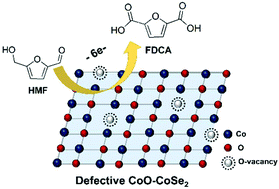当前位置:
X-MOL 学术
›
Green Chem.
›
论文详情
Our official English website, www.x-mol.net, welcomes your
feedback! (Note: you will need to create a separate account there.)
Enhancing the electrocatalytic activity of CoO for the oxidation of 5-hydroxymethylfurfural by introducing oxygen vacancies
Green Chemistry ( IF 9.3 ) Pub Date : 2019/12/23 , DOI: 10.1039/c9gc03698a Xin Huang 1, 2, 3, 4, 5 , Jinliang Song 1, 2, 3, 4, 5 , Manli Hua 1, 2, 3, 4, 5 , Zhenbing Xie 1, 2, 3, 4, 5 , Shuaishuai Liu 1, 2, 3, 4, 5 , Tianbin Wu 1, 2, 3, 4, 5 , Guanying Yang 1, 2, 3, 4, 5 , Buxing Han 1, 2, 3, 4, 5
Green Chemistry ( IF 9.3 ) Pub Date : 2019/12/23 , DOI: 10.1039/c9gc03698a Xin Huang 1, 2, 3, 4, 5 , Jinliang Song 1, 2, 3, 4, 5 , Manli Hua 1, 2, 3, 4, 5 , Zhenbing Xie 1, 2, 3, 4, 5 , Shuaishuai Liu 1, 2, 3, 4, 5 , Tianbin Wu 1, 2, 3, 4, 5 , Guanying Yang 1, 2, 3, 4, 5 , Buxing Han 1, 2, 3, 4, 5
Affiliation

|
The electrochemical oxidation of 5-hydroxymethylfurfural (HMF) to 2,5-furandicarboxylic acid (FDCA) is a highly attractive strategy to generate valuable biomass-based oxygenated chemicals. Robust, stable and inexpensive electrocatalysts are crucial for this interesting reaction. In this work, we found that the electrocatalytic performance of cobalt oxide (CoO) could be significantly improved by introducing oxygen vacancies via Se doping. The resulting CoO-CoSe2 with a CoO/CoSe2 molar ratio of 23 : 1 showed excellent performance and stability for the electro-oxidation of HMF to FDCA, and a FDCA yield of 99% could be achieved with a faradaic efficiency of 97.9% at a potential of 1.43 V vs. RHE. A systematic study indicates that the introduction of rich oxygen vacancies could enhance the catalytic activity and the selectivity to FDCA by increasing the electrochemical surface area and reducing charge transfer resistance. As far as we know, this is the first work to develop a highly stable metal oxide as the active component for this reaction.
中文翻译:

通过引入氧空位来增强CoO对5-羟甲基糠醛氧化的电催化活性
5-羟甲基糠醛(HMF)电化学氧化为2,5-呋喃二甲酸(FDCA)是产生有价值的基于生物质的含氧化合物的极具吸引力的策略。健壮,稳定和便宜的电催化剂对于这种有趣的反应至关重要。在这项工作中,我们发现通过通过Se掺杂引入氧空位可以显着提高氧化钴(CoO)的电催化性能。所得的CoO / CoSe 2摩尔比为23:1的CoO-CoSe 2对HMF氧化成FDCA表现出优异的性能和稳定性,并且可以以97.9%的法拉第效率获得FDCA的99%的产率。电压为1.43 V vs.RHE。一项系统的研究表明,引入富氧空位可通过增加电化学表面积和降低电荷转移阻力来增强催化活性和对FDCA的选择性。据我们所知,这是开发出高度稳定的金属氧化物作为该反应活性成分的第一项工作。
更新日期:2020-02-13
中文翻译:

通过引入氧空位来增强CoO对5-羟甲基糠醛氧化的电催化活性
5-羟甲基糠醛(HMF)电化学氧化为2,5-呋喃二甲酸(FDCA)是产生有价值的基于生物质的含氧化合物的极具吸引力的策略。健壮,稳定和便宜的电催化剂对于这种有趣的反应至关重要。在这项工作中,我们发现通过通过Se掺杂引入氧空位可以显着提高氧化钴(CoO)的电催化性能。所得的CoO / CoSe 2摩尔比为23:1的CoO-CoSe 2对HMF氧化成FDCA表现出优异的性能和稳定性,并且可以以97.9%的法拉第效率获得FDCA的99%的产率。电压为1.43 V vs.RHE。一项系统的研究表明,引入富氧空位可通过增加电化学表面积和降低电荷转移阻力来增强催化活性和对FDCA的选择性。据我们所知,这是开发出高度稳定的金属氧化物作为该反应活性成分的第一项工作。











































 京公网安备 11010802027423号
京公网安备 11010802027423号